
The top of the table Crows entered the season wanting to add versatility to allow them to rotate more players through the midfield. This has worked a treat. David Mackay has spent time across half-back, Charlie Cameron's pace has been an eye-catching addition through the midfield and on the wing, and defender Rory Laird has had short bursts on the ball. The Crows are also moving the ball quicker through their backline by hand. Their ratio of kicks to handballs in the defensive half has gone from 1.13:1 in 2016 (sixth in the AFL) to 0.89:1 this year (17th). When the Crows do kick out of defence, they go direct rather than messing around with the short option – 46.4 per cent (second in the League) of their kicks out of their defensive half are long kicks this year compared to 40.5 per cent (13th) in 2016. The lightning-quick ball movement of the Crows has resulted in their high-powered attack going to another level, even with key forwards Josh Jenkins and Mitch McGovern on the sideline. The Crows are averaging 133.2 points per game this year, up from 112.8 in 2016. Andy Otten has done a great job as a tall forward, while Eddie Betts, Taylor Walker and Tom Lynch are in superb form. - Lee Gaskin

The Lions are being scored against less from turnovers in the early stages of 2017, and a lot of this has to do with the way they're moving the ball from the defensive 50. Last season they moved the ball through the corridor more than any other team in the League (25 percent) when exiting the defensive 50. That meant that turnovers invariably led to scoring shots back the other way. But with new coach Chris Fagan on board, things have changed. Fagan has encouraged his players to take the simple option in the back half of the ground and so far that has led them to exiting the defensive 50 via the boundary line on 46.2 percent of occasions, which is still just 15th in the competition, but a long way up on the 38.3 percent of last season. With almost the same players both years, the result has been a reduction in points from turnovers – from 76 points a game to 62 a game. - Michael Whiting

It's no secret that the Blues are struggling to kick a winning score, which has been the case for several seasons. In the first five rounds they have gone with a different set-up, with talented youngster Jacob Weitering spending most of the time in attack and surrounded by other inexperienced players including Charlie Curnow, Jack Silvagni and Jarrod Pickett. But the statistics show Carlton has scored the fewest points of any team (339). Levi Casboult has improved his conversion and leads the way with nine goals, but he needs more help. Importantly, though, the Blues are not keeping the ball in their forward half for as long as they did last season. Their time in forward half this year is -6:27 (15th overall), compared with +1:23 in 2016 (seventh). Their forward-half stoppages and intercepts have also dropped this year. They average 26.4 forward-half stoppages (15th), down from 32.8 (sixth) in 2016. Forward-half intercepts have decreased from 23.8 (eighth) last season to 21.8 (12th) this year. - Howard Kotton
The Blues have thrust Jacob Weitering up forward to bolster their attack. Picture: AFL Photos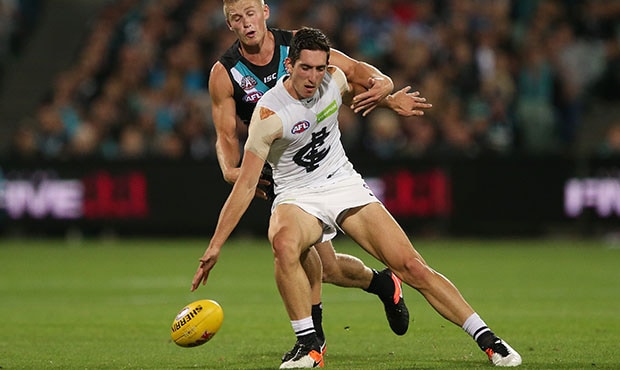

The Magpies hoped their midfield ascendancy would translate into winning scores but it hasn't happened. Despite improving their clearance differential from -0.2 to +5.8 to be ranked third and their points from clearance differential from -1.2 to +8.8 (fourth) they have not been able to kick goals. They are fifth for generating inside 50s behind four top-eight teams, but the sad facts are that Collingwood is about as efficient inside 50 as Carlton. Against St Kilda, the Pies' forward line got sucked too far up the ground while against Essendon it wasted chances. Their leading goalkicker is Alex Fasolo, with nine goals, but he is unreliable in front of goal having kicked 4.10 from set shots this season. Making matters worse is that the Magpies have struggled to defend turnovers conceding 308 points from them in the first five rounds. The reality is Collingwood relies too much on grunt with its only win coming on the tight spaces of the SCG when it laid 115 tackles but falls down on the outside and its defensive positioning. As coach Nathan Buckley said, they're not far away but are still miles off beating good teams. - Peter Ryan

Essendon's forward line is certainly more potent than last year (for obvious reasons) but also compared to recent seasons before its wooden-spoon finish in 2016. The Bombers are averaging 91.4 points a game so far this year, placing them 10th overall in the competition. This is a huge improvement on the 65 points they averaged last year, which saw them at the bottom of the league for points scored. The ever-dangerous presence of Orazio Fantasia (14 goals this season), alongside fellow small forward Josh Green and Anthony McDonald-Tipungwuti at the feet of Joe Daniher (12 goals) and Cale Hooker (nine goals) has created many more chances. The Bombers are scoring 49.6 per cent of the time they enter the forward 50, and are kicking a goal in 28.8 per cent of their inside-50 forays. This places them in third spot in the AFL, a big improvement from their efforts to kick a goal from 19.7 per cent of their entries last season, which ranked them last. When coach John Worsfold first arrived at Essendon at the end of 2015, he spoke about the team needing to score more. That was difficult last year given the circumstances, but so far this season the signs are positive. - Callum Twomey

The Dockers' stunning turnaround has owed to several factors – including some stellar spikes in form from their leaders – but Ross Lyon gave his team a simple focus after they slumped to 0-2: to ramp up their pressure. Everything has flowed from there. Tackles aren't always the best indicator of pressure, but after laying only 45 and 47 in the opening two rounds, Freo has been ferocious at the ball-carrier and wrapped up opponents 73 times in the nail-biting win over Melbourne at the MCG. Fremantle's clearance work has also been a feature, and was always going to improve with the returns of giant ruckman Aaron Sandilands and superstar midfielder Nat Fyfe this year after long-term injuries. It's no surprise that Freo leads the competition for hit-outs differential (+29.4), up from eighth spot last year (+2), especially with opponents no longer able to jump 'third man up' all over Sandilands at stoppages. Freo's clearance differential has also lifted, up to +5 per game (AFL No.4) from +0.9 (AFL No.7) last year. - Travis King

Joel Selwood says a positive aspect of the Cats' game this year has been their ability to stem the bleeding when the opposition has gathered momentum, which was something that troubled them at times in 2016; most memorably, in that first quarter in the preliminary final when the Sydney Swans piled on seven goals to nil. Zach Tuohy has been part of that, with his offensive and defensive work from half-back making an impact since he crossed from Carlton. Patrick Dangerfield is winning more hard ball and handballing more, which is increasing Selwood's and Mitch Duncan's involvement – with the latter playing more inside this year – while the team as a whole is kicking less and handballing more. The plan was to give players more time and space, and improve efficiency going inside 50. This year, when they go inside 50, they're being much more deliberate about how they do it, and they're kicking more goals from fewer entries as a result. And, they're doing it when it matters, with the team outscoring its opposition 191 to 38 in the last quarter from rounds two to five. Tom Hawkins is second in the Coleman Medal race with 18 goals, and while Harry Taylor's cameos in attack haves produced one solitary goal, his presence has occupied a defender and reduced the pressure on the Cats' full forward and fellow goal-kicker Daniel Menzel. – Jennifer Phelan
Zach Tuohy has slotted perfectly into Geelong's backline. Picture: AFL Photos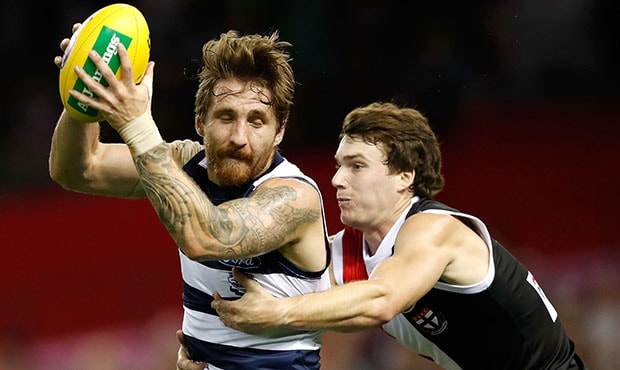

The one startling difference so far for the Suns this year has been their dramatic increase in uncontested possessions. Last season they had the second-worst differential in the competition, averaging 29 less a game than their opponent. Through five rounds in 2017, this has skyrocketed to a positive differential of 49 a game. This can be put down to a couple of reasons. Firstly, it's become evident coach Rodney Eade has encouraged his players to use more handballs when exiting stoppages, which often leads to two and three extra possessions to get into space. Secondly, they have a largely fit midfield again with plenty of good outside run available, with the likes of Aaron Hall, Gary Ablett, Michael Barlow, Matt Rosa and Jack Martin often finding space on the outside. Third, and finally, Gold Coast is trying to avoid the 'bomb long to Tom Lynch and Peter Wright' option, which characterised some of their play late last season. Instead, the midfielders have been encouraged to look for the small forwards and big guys once on the lead. - Michael Whiting

Despite their round one hiccup against Adelaide when they were soundly beaten, and some injury worries, the Giants have begun the season in ominous form, with their forwards in particular in great touch. After being ranked 17th in the competition last year and winning just 23.9 per cent of their offensive one-on-one contests, the 2017 Giants have shot up to second in the league, now winning 37.8 per cent. Jeremy Cameron has been a standout with career high averages in disposals and marks, while also booting 16 goals. Toby Greene (17 goals), Devon Smith and Jonathon Patton (eight), Rory Lobb (seven), and Steve Johnson and Sam Reid (six) are all averaging better than a goal a game, and are fantastic one-on-one players. - Adam Curley
Jeremy Cameron is back in form and the Giants are surging. Picture: AFL Photos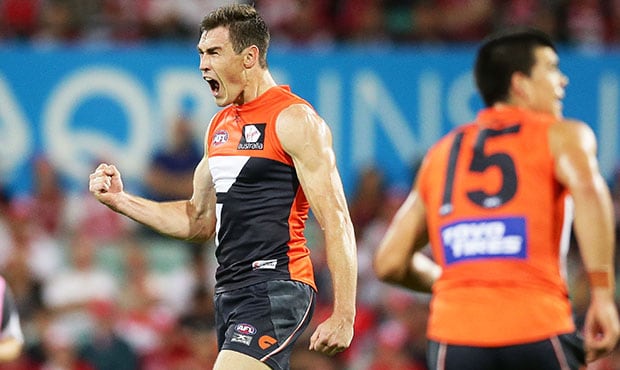

Stats for the season indicate that the Hawks are handballing more than they have in the past. Indeed, their kick-to-handball ratio in the back half has gone from 1.22:1 in 2016, which was second in the AFL last year, to 0.98:1, which is 15th. Across the entire ground, they have gone from 1.35:1 (ranked first in 2016) to 1.13:1, which is ranked 14th. The Hawks are better at winning contested ball this year, with the recruitment of Tom Mitchell and Jaeger O'Meara a key driver in that area. One win from five matches is a downward trend the Hawks need to fix. - Ashley Browne

A key mantra for Melbourne coach Simon Goodwin in the opening part of the season has been the need for his side to play fearless football and adopt a recognisable brand. The starting point for the Demons is being strong around the contest and aggressive with their defensive positioning and pressure. Although Melbourne has lost three consecutive games, its want and desire for the contest has not waned. The fact the Demons are now the fourth-ranked team in the competition for tackle differential (+5.6), after being 17th last season (-10.1), underlines the Goodwin influence. Melbourne is also first in the AFL for pressure factor (1.86), which is clearly a non-negotiable under Goodwin's coaching. With pressure high on opposition teams around the contest, Melbourne's defenders are more confidently able to set up in aggressive positions behind the footy. Richmond coach Damien Hardwick noted Melbourne's proactive zone setup after Monday's game and it is something that has confronted a lot of teams this season. From there, the payoff is the Demons have been able to move the ball with more dare and precision and already they are scoring more freely than last season. Melbourne remains a developing side (it had 12 players with fewer than 50 games experience against the Tigers) and is still prone to lapses in concentration at points in games, but the framework is there, and once the team's young players develop more consistency the Demons will be tough to beat. - Ben Guthrie

An 0-5 record generally doesn't lend itself to positive developments, and the Roos are no different. Rival teams are not only punishing them more on turnovers this season (23.3 per cent compared to 22.1 per cent last year), but they are leaking goals like a sieve in the fourth quarter. It is no coincidence then that North has given up multiple big leads and suffered losses by five or fewer points three times. The Kangaroos' daring approach of using the corridor more often out of defensive 50 – 24.8 per cent of the time, up from 15 per cent in 2016 – helps explain opposition sides' greater potency on turnovers. Figuring out why North has conceded five goals or more in every fourth quarter this season is tougher. You have to go back to round 20 last year against the Dogs to find a game where the blue-and-white won a final term. Are Brad Scott's men not fit enough? That seems too simplistic. Fremantle stars Nat Fyfe and David Mundy were enormous down the stretch on Saturday night, so maybe the answer lies with the Roos' leaders. Not even Marley Williams' brilliant chase down could inspire the team to hold on. - Marc McGowan

Turnovers were a major source of frustration for the Power last year, but in the opening five rounds they have gone some way to rectifying that problem. It all comes down to patience, better decision-making and ball use. The Power led the League in clangers in 2016, averaging 58 per game. This season, that average is down to 52, 11th in the competition. Part of the reason is because they are playing on less after they take a mark, from 42.5 per cent (second) in 2016 to 32.3 per cent (17th) this year. The Power's disposal efficiency has also improved from 70.7 per cent (seventh) to 72.1 per cent (4th). The Power's attack is more potent than last year on the back of Robbie Gray spending more time in the forward 50. Gray has booted 14 goals in five games, well on track to eclipse his career-high of 42 goals in a season set in 2014. The return of ruckman Patrick Ryder has allowed the Power's midfielders first use of the ball, one of the reasons why they have the most Inside 50s in the competition at 61 per game. - Lee Gaskin
Paddy Ryder is giving Port's midfield an armchair ride. Picture: AFL Photos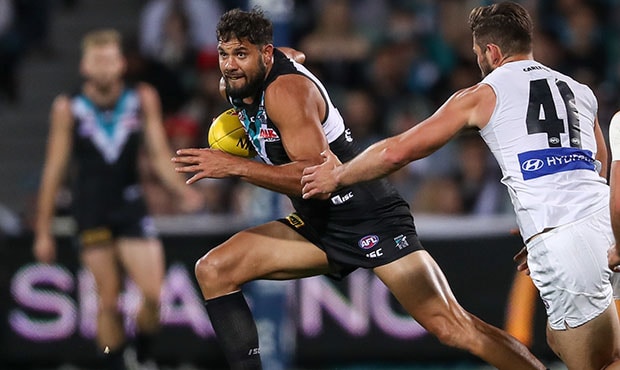

The biggest change in the Tigers' game this season has been their ability to press up the ground and force turnovers in their own forward half, rather than setting up attacks from half-back like they were forced to in 2016. The key to this change has been the impact of small forwards Dan Butler, Jason Castagna and Daniel Rioli, as well as the willingness of all other forwards to tackle and chase. Across the first four rounds, the Tigers ranked fourth for time in forward half (up from 15th in 2016), and seventh for forward half stoppages (16th in 2016). They were No.1 for forward-half intercepts (16th in 2016), converting those into an average of 43.5 points a game, also No.1 in the League. The method Richmond is using to get the ball forward has also changed significantly, taking a gung-ho approach to their ball movement and playing on instinct. It results in occasional turnovers, but the risk is outweighed by the reward at this stage of the season and the coaches are excusing turnovers when the players have the right mindset. The new style is summed up best when Dustin Martin is isolated inside 50 and given chances to win one-on-one contests because of the rapid ball-movement. - Nathan Schmook

The Saints have scored more when going forward. Last year, they scored on 44.9 per cent of inside-50s to rank 13th in the competition. So far in 2017, they are second at 53.2 per cent. The club identified scoring efficiency as a problem during the pre-season and worked to change the way it brought the ball into attack. In terms of personnel, not much has changed. Josh Bruce and Tim Membrey spend most of their time up forward while Nick Riewoldt rotates between the wing and attack. Paddy McCartin has played two games this year and wasn't a fixture in the side in 2016 either. Accuracy has been a concern – St Kilda is ranked 16th in that category, ahead of only the Western Bulldogs and Collingwood. Bruce (7.7) and Membrey (7.5) would be disappointed with some of their misses, while Jade Gresham (6.9), Mav Weller (5.7) and Jack Billings (2.6) have been wayward. Coach Alan Richardson has talked about the need to improve the connection between the "kickers and catchers", referring to shots not coming from where the Saints want them. Improving that would help solve the goalkicking issues. - Dinny Navaratnam
Jade Gresham has been misfiring in front of goal this year. Picture: AFL Photos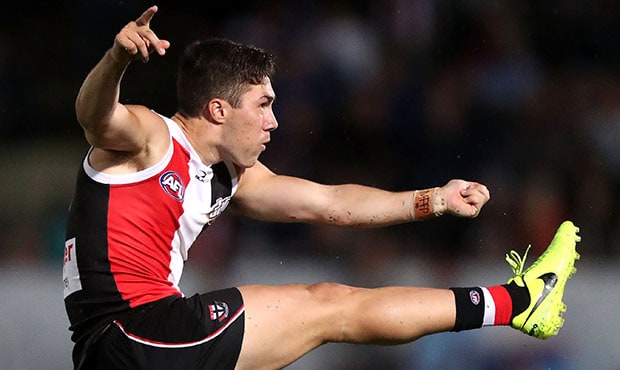

With the Swans sitting on the bottom of the ladder and still yet to win a game, there's little surprise that their major trend is a downward spiral in winning the footy. The Swans have gone from being ranked fourth for disposals differential last year (+26.9), to 16th this season (-41.2), with their contested possession differential dropping even further from third (+11.5) to 17th (-13.8). The uncontested side of it is not much better, the Swans plummeting from fifth (+16.3) to 16th (-31.6) in 2017. In short, Sydney's star midfielders can't get their hands on it enough to be the dominant force they have been in recent years. Josh Kennedy and Luke Parker have shown glimpses but are down on disposals (-4), with Kieren Jack (-7) and Dan Hannebery (-8) struggling even more. - Adam Curley

West Coast's number one problem this season has clearly been the players' mindset and intent at the contest, which has fluctuated wildly in their wins and losses. In victories over North Melbourne, St Kilda and Sydney, the Eagles either narrowly won or lost the contested ball count, with the margin too insignificant to be decisive. When Adam Simpson's side is competitive in contested situations, the Eagles can cut teams up with their skills and have been able to make their opponents chase. West Coast's uncontested disposals differential has skyrocketed this year, increasing from -22.2 per game (AFL No.15) last season to +27.6 (AFL No.4) in 2017. But in both defeats to Richmond and Hawthorn at the MCG, the Eagles have been smashed in the contest and lost the overall possession count. It's a major headache that Simpson had identified well before last Sunday's humbling from the Hawks, but fixing it is the issue. - Travis King

The premiers have improved their scoring efficiency significantly this season, with scores per inside 50 rising from 15th in 2016 (43.6 per cent) to third best at 52.9 per cent. The Dogs have also enhanced their ability to hurt the opposition rebounding from defensive 50, jumping from a lowly 16th (15.1 per cent) to the AFL's second best efficiency of 22.1 per cent. However, coach Luke Beveridge would be frustrated that his side's goal kicking has remained poor, with the Dogs dipping from an average of 47 per cent last season to second last with 43 per cent. While the Dogs have remained one of the competition's highest possession sides, they are laying more tackles in 2017. They are currently the number one tackling team (384) with an average of 76 per game, up from 67 per cent. - Ryan Davidson



